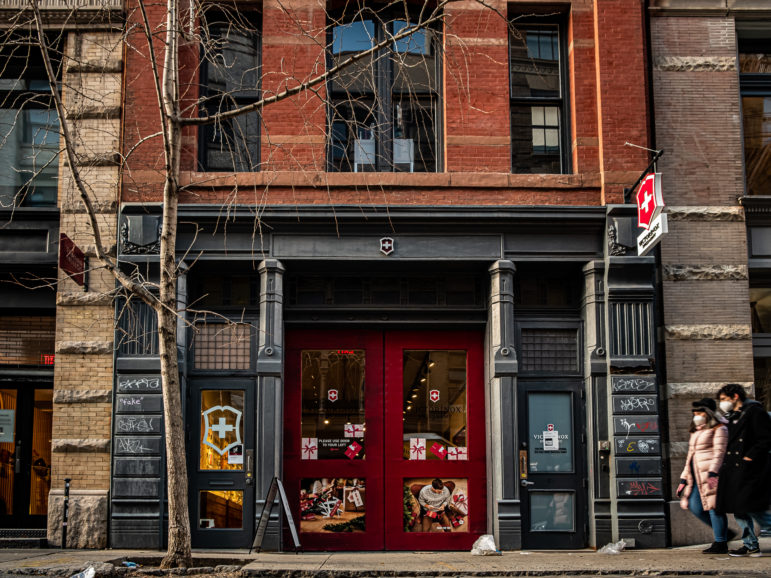The de Blasio administration wants to upzone a 56-block swath of the Lower Manhattan neighborhoods, where elite boutiques and wealthy arrivistes have replaced the manufacturing sites and artists that characterized the area a half-century ago.

Adi Talwar
Located in SoHo’s Cast Iron Historic District, 99 Wooster St. hosts a former firehouse built in the early 1850s. It was designated as a landmark site in 2019 by the Landmarks Preservation Commission.The public review process on a plan to rezone SoHo and NoHo is a go.
The City Planning Commission (CPC) on Monday certified the de Blasio administration’s application to upzone a 56-block swath of the Lower Manhattan neighborhoods, where elite boutiques and and multi-million dollar lofts have replaced the manufacturing sites and artists that characterized the area a half-century ago.
Mayor Bill de Blasio has sought to change the zoning rules in the project area to add up to 3,200 new units, including up to 900 apartments priced below market rate, while creating concrete rules for what sorts of businesses can move in.
The land use plan would cover the area bound by Astor Place and Houston Street to the north; Bowery, Lafayette and Baxter streets to the east; Canal Street to the south, and Sixth Avenue, West Broadway and Broadway to the west.
“Every New Yorker should have the opportunity to live in transit-rich, amenity-filled neighborhoods like SoHo and NoHo,” said CPC Chair Marisa Lago in a statement. “Through permanently affordable housing requirements and support for the arts, this plan is a giant step forward towards a more equitable and even livelier New York City.”
The effort to rezone the neighborhoods is a break from de Blasio’s past rezoning initiatives, which have focused on low and middle-income communities of color, where land is cheaper and residents have less political capital. The administration is also seeking to rezone Gowanus, Brooklyn, before de Blasio leaves office at the end of the year.
SoHo, in contrast, is rich, predominantly white and home to various historic districts, which cover 85 percent of the proposed rezoning area.
The proposal, known as the SoHo/NoHo Neighborhood Plan, would increase density by allowing building heights to reach 275 feet outside the historic districts and along Canal Street and the Bowery.
The plan would also allow residents living in Joint Living Work Quarters for Artists (JLWQA) to convert to residential zoning by contributing to an artists fund. JLWQA is a neighborhood-specific designation that permits artists to live in an otherwise manufacturing-only zone.
Opponents of the plan, however, say the proposal will provide a minuscule amount of affordable housing while threatening the historic character of the area with high-rise buildings.
“Wrapped in a false veneer of affordable housing and social justice equity, de Blasio’s SoHo/NoHo proposal is a fire sale giveaway of enormously valuable real estate that will destroy hundreds of units of existing affordable housing and create few if any new ones,” said Village Preservation Executive Director Andrew Berman in a statement.
Berman said the plan will “displace hundreds of lower-income residents and residents of color” while making the area less affordable and “pushing out the remaining independent small businesses with a flood of big-box chain retail.”
Village Preservation, the city’s largest neighborhood preservation group, has created an alternate plan it says will create more affordable housing than the city’s proposal.
The Department of City Planning contends that no new towers will be permitted under the rezoning plan.
Under the city’s Universal Land Use Review Procedure (ULURP), Manhattan’s Community Board 2 will have 60 days to review the proposal.









One thought on “Public Review Process Begins for SoHo Rezoning Plan”
There are several errors in this report.
1- “create concrete rules to prevent big box stores from moving in “
Quite the contrary.
There is currently a limit of 10,000 sq ft for retail.
de Blasio wants to remove that limit entirely, heralding destination stores like Home Depot, Target, BedBathBeyond etc, of UNLIMITED square footage, not the local stores allowed now and the boutiques you mention
2- There is no guarantee that any affordable housing will be built but there is credible evidence that all the luxury housing proposed will put displacement pressure on existing low-rent or rent-regulated tenants.
3- It is a free gift of millions of square feet of new developable air-rights to developers, some of whom have given handsomely to de Blasio’s campaign. Yet the community gets nothing in return except 27-story office towers. Sound familiar?
4- Although “wealthy arrivistes” have come into the neighborhood, City Planning’s own data reveals 1/3 of the residents are rent-regulated and another 1/3 live in “artist lofts” many paying incredibly low maintenance. Don’t believe the mayor’s hype.